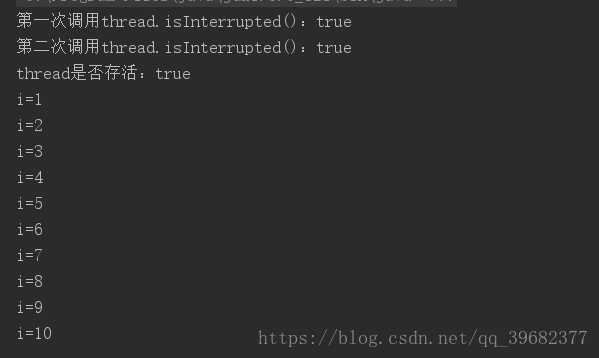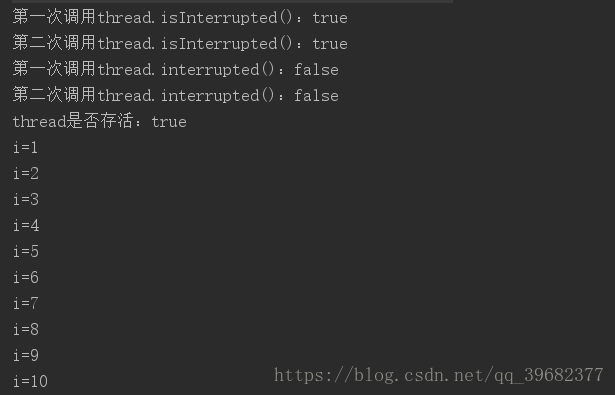线程中断:Thread类中interrupt()、interrupted()和 isInterrupted()方法详解
首先看看官方说明:
interrupt()方法

其作用是中断此线程(此线程不一定是当前线程,而是指调用该方法的Thread实例所代表的线程),但实际上只是给线程设置一个中断标志,线程仍会继续运行。
interrupted()方法

作用是测试当前线程是否被中断(检查中断标志),返回一个boolean并清除中断状态,第二次再调用时中断状态已经被清除,将返回一个false。
isInterrupted()方法

作用是只测试此线程是否被中断 ,不清除中断状态
下面我们进行测试说明:
定义一个MyThread类,继承Thread,如下:
public class MyThread extends Thread { @Override public void run() { for (int i = 0; i < 10; i++) { System.out.println("i="+(i+1)); } } }
在main方法中测试:
public class Do { public static void main(String[] args ) { MyThread thread=new MyThread(); thread.start(); thread.interrupt(); System.out.println("第一次调用thread.isInterrupted():"+thread.isInterrupted()); System.out.println("第二次调用thread.isInterrupted():"+thread.isInterrupted()); System.out.println("thread是否存活:"+thread.isAlive()); } }
输出如下:

从结果可以看出调用interrupt()方法后,线程仍在继续运行,并未停止,但已经给线程设置了中断标志,两个isInterrupted()方法都会输出true,也说明isInterrupted()方法并不会清除中断状态。
下面我们把代码修改一下,多加两行调用interrupted()方法:
public class Do { public static void main(String[] args ) { MyThread thread=new MyThread(); thread.start(); thread.interrupt(); System.out.println("第一次调用thread.isInterrupted():"+thread.isInterrupted()); System.out.println("第二次调用thread.isInterrupted():"+thread.isInterrupted()); //测试interrupted()函数 System.out.println("第一次调用thread.interrupted():"+thread.interrupted()); System.out.println("第二次调用thread.interrupted():"+thread.interrupted()); System.out.println("thread是否存活:"+thread.isAlive()); } }
输出如下:

从输出结果看,可能会有疑惑,为什么后面两个interrupted方法输出的都是false,而不是预料中的一个true一个false?注意!!!这是一个坑!!!上面说到,interrupted()方法测试的是当前线程是否被中断,当前线程!!!当前线程!!!,这里当前线程是main线程,而thread.interrupt()中断的是thread线程,这里的此线程就是thread线程。所以当前线程main从未被中断过,尽管interrupted()方法是以thread.interrupted()的形式被调用,但它检测的仍然是main线程而不是检测thread线程,所以thread.interrupted()在这里相当于main.interrupted()。对于这点,下面我们再修改进行测试。
Thread.currentThread()函数可以获取当前线程,下面代码中获取的是main线程
public class Do { public static void main(String[] args ) throws InterruptedException { Thread.currentThread().interrupt(); System.out.println("第一次调用Thread.currentThread().interrupt():" +Thread.currentThread().isInterrupted()); System.out.println("第一次调用thread.interrupted():" +Thread.currentThread().interrupted()); System.out.println("第二次调用thread.interrupted():" +Thread.currentThread().interrupted()); } }
这里都是针对当前线程在操作,如果interrupted()方法有检测中断并清除中断状态的作用,预料中的输出应该是true-true-false,实际输出如下:

结果证明猜想是正确的。
若果想要是实现调用interrupt()方法真正的终止线程,则可以在线程的run方法中做处理即可,比如直接跳出run()方法使线程结束,视具体情况而定,下面是一个例子。
修改MyThread类:
public class MyThread extends Thread { @Override public void run() { for (int i = 0; i < 1000; i++) { System.out.println("i="+(i+1)); if(this.isInterrupted()){ System.out.println("通过this.isInterrupted()检测到中断"); System.out.println("第一个interrupted()"+this.interrupted()); System.out.println("第二个interrupted()"+this.interrupted()); break; } } System.out.println("因为检测到中断,所以跳出循环,线程到这里结束,因为后面没有内容了"); } }
测试MyThread:
public class Do { public static void main(String[] args ) throws InterruptedException { MyThread myThread=new MyThread(); myThread.start(); myThread.interrupt(); //sleep等待一秒,等myThread运行完 Thread.currentThread().sleep(1000); System.out.println("myThread线程是否存活:"+myThread.isAlive()); } }
结果:

总结:
关于这三个方法,interrupt()是给线程设置中断标志;
interrupted()是检测中断并清除中断状态;
isInterrupted()只检测中断。
还有重要的一点就是interrupted()作用于当前线程,interrupt()和isInterrupted()作用于此线程,即代码中调用此方法的实例所代表的线程。
-------------------------------------------对线程中断的理解-------------------------------------------
首先,一个线程不应该由其他线程来强制中断或停止,而是应该由线程自己自行停止。
所以,Thread.stop, Thread.suspend, Thread.resume 都已经被废弃了。
而 Thread.interrupt 的作用其实也不是中断线程,而是「通知线程应该中断了」,
具体到底中断还是继续运行,应该由被通知的线程自己处理。
具体来说,当对一个线程,调用 interrupt() 时,
① 如果线程处于被阻塞状态(例如处于sleep, wait, join 等状态),那么线程将立即退出被阻塞状态,并抛出一个InterruptedException异常。仅此而已。
② 如果线程处于正常活动状态,那么会将该线程的中断标志设置为 true,仅此而已。被设置中断标志的线程将继续正常运行,不受影响。
也就是说,一个线程如果有被中断的需求,那么就可以这样做。
① 在正常运行任务时,经常检查本线程的中断标志位,如果被设置了中断标志就自行停止线程。
② 在调用阻塞方法时正确处理InterruptedException异常。(例如,catch异常后就结束线程。)
Thread thread = new Thread(() -> { while (!Thread.interrupted()) { // do more work. } }); thread.start(); // 一段时间以后 thread.interrupt();
如果一个线程被设置中断标志后,选择结束线程那么自然不存在下次的问题,
而如果一个线程被设置中断标识后,进行了一些处理后选择继续进行任务,
而且这个任务也是需要被中断的,那么当然需要清除标志位了。
例子:
public class Test { public static void main(String[] args) throws InterruptedException { // sleepThread睡眠1000ms final Thread sleepThread = new Thread() { @Override public void run() { try { Thread.sleep(1000); } catch (InterruptedException e) { e.printStackTrace(); } super.run(); } }; // busyThread一直执行死循环 Thread busyThread = new Thread() { @Override public void run() { while (true); } }; sleepThread.start(); busyThread.start(); sleepThread.interrupt(); // 改变中断状态标志位 busyThread.interrupt(); System.out.println(busyThread.isInterrupted()); while (sleepThread.isInterrupted()); // 一直死循环等待该中断标志位被改变才继续执行下面的代码 System.out.println("sleepThread isInterrupted: " + sleepThread.isInterrupted()); System.out.println("busyThread isInterrupted: " + busyThread.isInterrupted()); } }
输出:

出处:
https://blog.csdn.net/qq_39682377/article/details/81449451
https://www.zhihu.com/question/41048032


 浙公网安备 33010602011771号
浙公网安备 33010602011771号